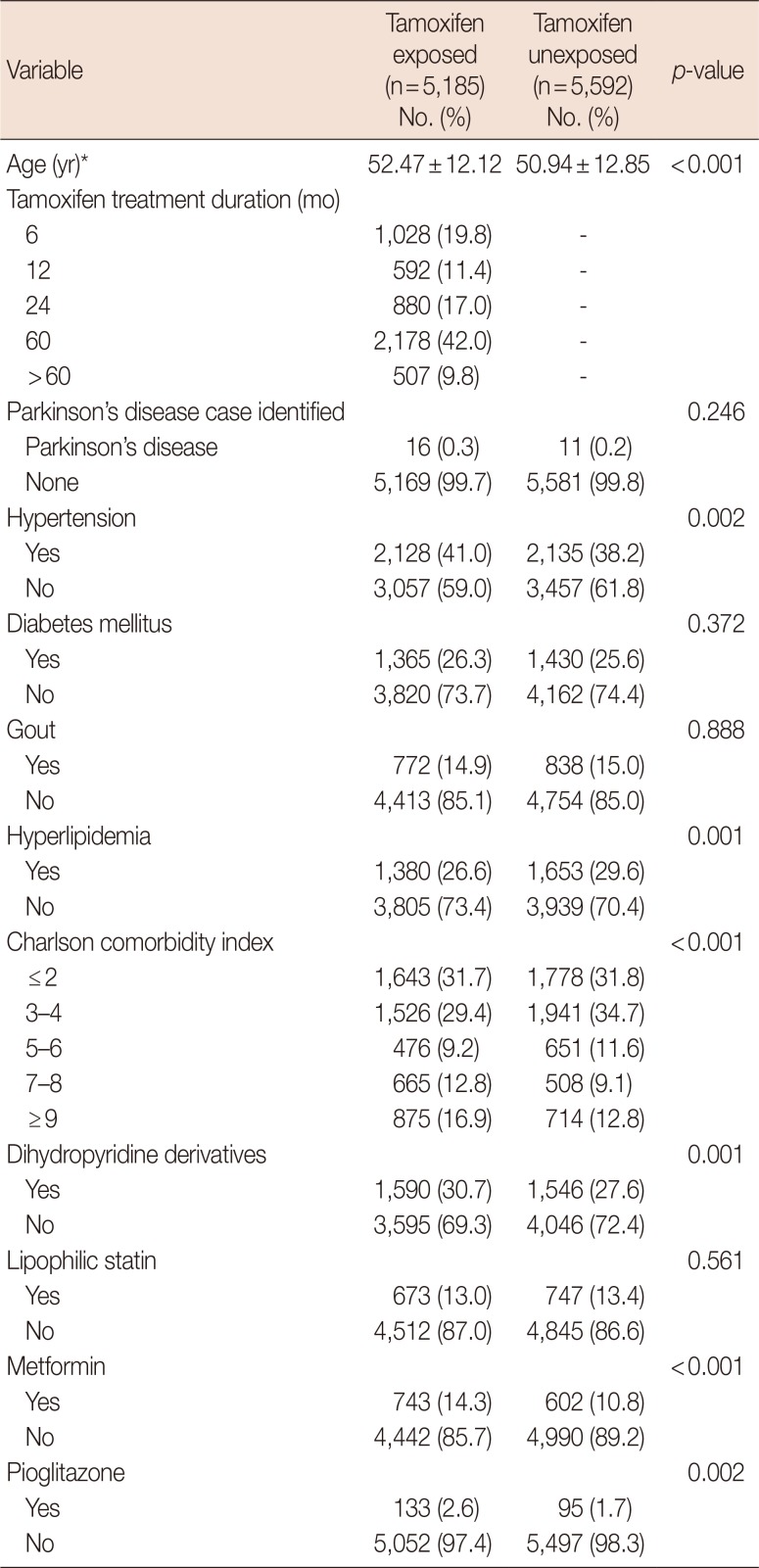1. Trimmer PA, Bennett JP Jr. The cybrid model of sporadic Parkinson's disease. Exp Neurol. 2009; 218:320–325. PMID:
19328199.

2. Kieburtz K, Wunderle KB. Parkinson's disease: evidence for environmental risk factors. Mov Disord. 2013; 28:8–13. PMID:
23097348.

3. Van Den Eeden SK, Tanner CM, Bernstein AL, Fross RD, Leimpeter A, Bloch DA, et al. Incidence of Parkinson's disease: variation by age, gender, and race/ethnicity. Am J Epidemiol. 2003; 157:1015–1022. PMID:
12777365.

4. Wooten GF, Currie LJ, Bovbjerg VE, Lee JK, Patrie J. Are men at greater risk for Parkinson's disease than women? J Neurol Neurosurg Psychiatry. 2004; 75:637–639. PMID:
15026515.

5. Currie LJ, Harrison MB, Trugman JM, Bennett JP, Wooten GF. Postmenopausal estrogen use affects risk for Parkinson disease. Arch Neurol. 2004; 61:886–888. PMID:
15210525.

6. Gatto NM, Deapen D, Stoyanoff S, Pinder R, Narayan S, Bordelon Y, et al. Lifetime exposure to estrogens and Parkinson's disease in California teachers. Parkinsonism Relat Disord. 2014; 20:1149–1156. PMID:
25179495.

7. Latourelle JC, Dybdahl M, Destefano AL, Myers RH, Lash TL. Risk of Parkinson's disease after tamoxifen treatment. BMC Neurol. 2010; 10:23. PMID:
20385012.

8. Lee ES, Yin Z, Milatovic D, Jiang H, Aschner M. Estrogen and tamoxifen protect against Mn-induced toxicity in rat cortical primary cultures of neurons and astrocytes. Toxicol Sci. 2009; 110:156–167. PMID:
19383943.

9. Mosquera L, Colón JM, Santiago JM, Torrado AI, Meléndez M, Segarra AC, et al. Tamoxifen and estradiol improved locomotor function and increased spared tissue in rats after spinal cord injury: their antioxidant effect and role of estrogen receptor alpha. Brain Res. 2014; 1561:11–22. PMID:
24637260.

10. Lin HL, Lin HC, Tseng YF, Chen SC, Hsu CY. Inverse association between cancer and dementia: a population-based registry study in Taiwan. Alzheimer Dis Assoc Disord. 2016; 30:118–122. PMID:
26523711.
11. You CW, Rau HH, Chang YC, Chen LF, Hung JF, Lin YA, et al. Design a service model with cloud computing architecture for value-added applications of health data. J Taiwan Assoc Med Inform. 2015; 24:33–41.
12. Lee YC, Lin CH, Wu RM, Lin MS, Lin JW, Chang CH, et al. Discontinuation of statin therapy associates with Parkinson disease: a population-based study. Neurology. 2013; 81:410–416. PMID:
23884037.

13. De Vera M, Rahman MM, Rankin J, Kopec J, Gao X, Choi H. Gout and the risk of Parkinson's disease: a cohort study. Arthritis Rheum. 2008; 59:1549–1554. PMID:
18975349.

14. Alonso A, Rodríguez LA, Logroscino G, Hernán MA. Gout and risk of Parkinson disease: a prospective study. Neurology. 2007; 69:1696–1700. PMID:
17954784.

15. Sun Y, Chang YH, Chen HF, Su YH, Su HF, Li CY. Risk of Parkinson disease onset in patients with diabetes: a 9-year population-based cohort study with age and sex stratifications. Diabetes Care. 2012; 35:1047–1049. PMID:
22432112.

16. Charlson ME, Pompei P, Ales KL, MacKenzie CR. A new method of classifying prognostic comorbidity in longitudinal studies: development and validation. J Chronic Dis. 1987; 40:373–383. PMID:
3558716.

17. Bourque M, Liu B, Dluzen DE, Di Paolo T. Tamoxifen protects male mice nigrostriatal dopamine against methamphetamine-induced toxicity. Biochem Pharmacol. 2007; 74:1413–1423. PMID:
17825264.

18. Mickley KR, Dluzen DE. Dose-response effects of estrogen and tamoxifen upon methamphetamine-induced behavioral responses and neurotoxicity of the nigrostriatal dopaminergic system in female mice. Neuroendocrinology. 2004; 79:305–316. PMID:
15256808.

19. Gao X, Dluzen DE. Tamoxifen abolishes estrogen's neuroprotective effect upon methamphetamine neurotoxicity of the nigrostriatal dopaminergic system. Neuroscience. 2001; 103:385–394. PMID:
11246153.

20. Bower JH, Maraganore DM, McDonnell SK, Rocca WA. Incidence and distribution of parkinsonism in Olmsted County, Minnesota, 1976-1990. Neurology. 1999; 52:1214–1220. PMID:
10214746.

21. Kuopio AM, Marttila RJ, Helenius H, Rinne UK. Changing epidemiology of Parkinson's disease in southwestern Finland. Neurology. 1999; 52:302–308. PMID:
9932948.

22. Chen RC, Chang SF, Su CL, Chen TH, Yen MF, Wu HM, et al. Prevalence, incidence, and mortality of PD: a door-to-door survey in Ilan county, Taiwan. Neurology. 2001; 57:1679–1686. PMID:
11706111.

23. Wang YS, Shi YM, Wu ZY, He YX, Zhang BZ. Coordinational Group of Neuroepidemiology, PLA. Parkinson's disease in China. Chin Med J(Engl). 1991; 104:960–964. PMID:
1800040.
24. Liu B, Dluzen DE. Oestrogen and nigrostriatal dopaminergic neurodegeneration: animal models and clinical reports of Parkinson's disease. Clin Exp Pharmacol Physiol. 2007; 34:555–565. PMID:
17581209.

25. Graham CD, Kaza N, Klocke BJ, Gillespie GY, Shevde LA, Carroll SL, et al. Tamoxifen induces cytotoxic autophagy in glioblastoma. J Neuropathol Exp Neurol. 2016; 75:946–954. PMID:
27516117.

26. Ribeiro MP, Santos AE, Custódio JB. Mitochondria: the gateway for tamoxifen-induced liver injury. Toxicology. 2014; 323:10–18. PMID:
24881593.

27. Tsai YW, Tsai TI, Yang CL, Kuo KN. Gender differences in smoking behaviors in an Asian population. J Womens Health (Larchmt). 2008; 17:971–978. PMID:
18681817.

28. Vollenweider-Zerargui L, Barrelet L, Wong Y, Lemarchand-Béraud T, Gómez F. The predictive value of estrogen and progesterone receptors' concentrations on the clinical behavior of breast cancer in women. Clinical correlation on 547 patients. Cancer. 1986; 57:1171–1180. PMID:
3943040.

29. Hähnel R, Woodings T, Vivian AB. Prognostic value of estrogen receptors in primary breast cancer. Cancer. 1979; 44:671–675. PMID:
476576.

30. Senkus E, Kyriakides S, Ohno S, Penault-Llorca F, Poortmans P, Rutgers E, et al. Primary breast cancer: ESMO clinical practice guidelines for diagnosis, treatment and follow-up. Ann Oncol. 2015; 26(Suppl 5):v8–v30. PMID:
26314782.








 PDF
PDF ePub
ePub Citation
Citation Print
Print


 XML Download
XML Download